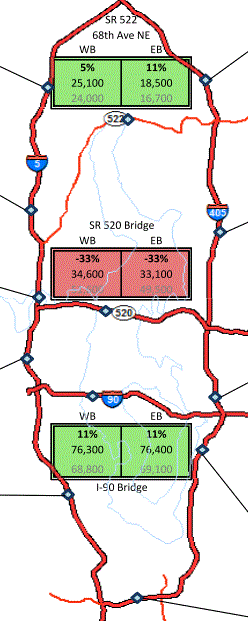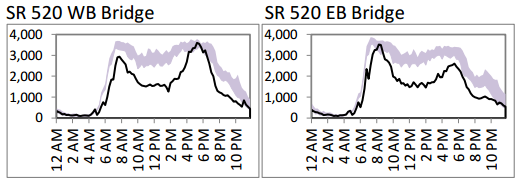 After a topsy-turvy first couple of months—first vacations, then snow—traffic on the newly-tolled SR-520 bridge across Lake Washington seems to have stabilized at about 67,000 cars per day. That’s down by about a third from last fall’s level, just before the tolls were first levied.
After a topsy-turvy first couple of months—first vacations, then snow—traffic on the newly-tolled SR-520 bridge across Lake Washington seems to have stabilized at about 67,000 cars per day. That’s down by about a third from last fall’s level, just before the tolls were first levied.
But data from the Washington State Department of Transportation shows most of the trips that “disappeared” from SR-520 simply migrated to other roads. Traffic on SR-522 around the north end of Lake Washington has increased by about 3,400 cars per day, an 8 percent uptick. And traffic on I-90 has grown by about 15,400 cars per day, or about 11 percent. So of the 34,000 weekday car trips that have “vanished” from SR-520, somewhere between 18,000 and 19,000 are simply taking alternative routes. As we said last year, high rates of toll avoidance were completely predictable; and folks tracking other tolling projects in the Northwest, including the Columbia River Crossing and the Alaskan Way Viaduct tunnel, should take careful note of SR-520’s diversion rates.
Combining all 3 routes—SR-520, I-90 and SR-522—cross-lake traffic has declined by 6 percent, give or take. Of course, vehicle miles traveled for cross-lake trips have likely declined by less than 6 percent, since some folks are undoubtedly taking longer cross-lake trips to avoid the tolls. We won’t know for a while whether tolls have actually taken a bite out of vehicle travel. But regardless, WSDOT’s tolling experiment has proved one thing: tolling even one segment of a road network can substantially alter driving patterns.
Looking through the state’s figures, there are a couple of additional data points to keep an eye on…
The first is the question of how tolls have affected traffic at different times of day. A mid-February comparison of post-tolling 520 traffic volumes (the black lines) with pre-tolling levels (the gray bands) shows that peak rush-hour traffic is pretty close to what it was before tolling.
 In particular, folks commuting from Seattle to the Eastside and back have proven particularly willing to pay tolls: traffic eastbound during the morning rush hour, and westbound during the afternoon rush hour, is in the same range as pre-tolling levels. But mid-day traffic is well below pre-tolling levels. Without looking at the actual numbers, it’s hard to know how much of that mid-day traffic is simply diverting to other routes. But if my eyes don’t deceive me, WSDOT’s charts (see page 4 of this pdf, for example) suggest there’s a lot of mid-day traffic on SR-520 that has simply disappeared—that is, SR-520 has gone down more than traffic on 522 and I-90 has gone up. You should feel free to insert your own interpretation here: either mid-day tolls are “too high” because they’re discouraging travel without actually relieving congestion; or they’re “just fine” because they’re helping to raise revenue for the new bridge by charging the people who actually use it.
In particular, folks commuting from Seattle to the Eastside and back have proven particularly willing to pay tolls: traffic eastbound during the morning rush hour, and westbound during the afternoon rush hour, is in the same range as pre-tolling levels. But mid-day traffic is well below pre-tolling levels. Without looking at the actual numbers, it’s hard to know how much of that mid-day traffic is simply diverting to other routes. But if my eyes don’t deceive me, WSDOT’s charts (see page 4 of this pdf, for example) suggest there’s a lot of mid-day traffic on SR-520 that has simply disappeared—that is, SR-520 has gone down more than traffic on 522 and I-90 has gone up. You should feel free to insert your own interpretation here: either mid-day tolls are “too high” because they’re discouraging travel without actually relieving congestion; or they’re “just fine” because they’re helping to raise revenue for the new bridge by charging the people who actually use it.
A second number to keep an eye on is the baseline against which SR-520’s “declines” are being measured.
To gauge the effects of tolling, WSDOT has been comparing the weekly traffic volumes on SR-520 with a recent “baseline”: six holiday-free weeks last October, November, and December. During those weeks, SR-520 carried about 101,000 vehicles per workday. But WSDOT’s most recent Ramp and Roadways Report found that traffic on SR-520 topped 112,000 vehicles on the average weekday—a figure that’s about 11 percent higher than the baseline that WSDOT is using to gauge the effects of tolling. To confuse things further, for years WSDOT has been saying things like this: “Over 115,000 drivers now use the 520 bridge every day.” (Nota bene: This is false: it applies only to weekdays, not “every” day; and besides, weekday traffic hasn’t been that high since 2000!) In short, the “baseline” that WSDOT is using to gauge post-tolling traffic trends is significantly lower than the “baseline” that WSDOT has been reporting for other purposes.
For now, the lower baseline reported by WSDOT is reasonable enough, since late fall and winter tend to have less traffic than the summertime. But as summer approaches, keep an eye on that baseline!! If WSDOT doesn’t adjust the SR-520 traffic baseline upwards to account for the summertime boost in traffic, I think it’d be fair to say that they’d moved the goal posts.

Comments are closed.